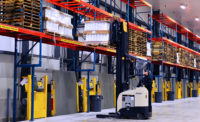How automation solves the top challenges of modern food distribution
Rapid and accurate fulfillment can be a challenge for facilities reliant on manual processes.

From rising consumer demands and shrinking order windows to stringent regulations and costly recalls, the food and beverage industry is facing unprecedented challenges when it comes to product quality, safety and shelf life. One of the most critical components of today’s complex food supply chain is the distribution center, where the efficient flow of products throughout the facility is essential—particularly for temperature-sensitive goods in the cold chain.
However, rapid and accurate fulfillment can be a challenge for facilities reliant on manual processes. Order picking by warehouse staff in refrigerated or frozen environments not only takes considerable time (due to regular warm-up breaks), but is also physically strenuous and prone to costly human errors.
Instead, automation offers food and beverage companies a modern approach to distribution. Robotic order fulfillment solutions can manage entire operations from product receipt and storage to the shipping dock. This complete control over material flow can help companies tackle their toughest distribution challenges head on.
Meeting demand for variation and SKU proliferation
With the rise of e-commerce, today’s consumers are accustomed to buying exactly what they want, when they want it—and have come to expect the same variety of options when shopping for their groceries. In response, many food and beverage brands now offer more product variations than ever before, including more sizes, flavors and packaging types.
This demand has led to a proliferation in SKUs, with many distribution centers seeing a dramatic rise from several hundred to thousands of units. Manual warehouses may struggle to accommodate such sizable inventory growth, especially in older facilities designed with smaller quantities in mind.
Managing seasonal peaks and labor shortages
In nearly every industry, distribution centers are experiencing labor shortages, as aging employees retire in record numbers. Of those entering the workforce, fewer and fewer are considering warehousing as a viable career option, largely due to safety concerns. This is especially true for cold storage facilities where employees must pick products in cold, harsh environments.
Though these shortages affect companies year-round, manual facilities are hit especially hard during peak seasons. Operations easily fall behind as sales spike—unable to keep up with order volumes or efficiently manage higher inventory levels. While some facilities hire seasonal employees or add additional overtime shifts, these short-term solutions wind up creating other challenges in added labor costs and ergonomic concerns down the road.
Minimizing labor requirements and risk of employee safety was one of the main reasons that Kroger, Cincinnati, decided to automate its Mountain View Foods plant for liquid milk production. When developing the state-of-the-art facility, Kroger invested in an end-to-end automated product handling solution.
The solution handles stacks of plastic dairy cases on plastic belt conveyors. Cases or stacks are picked according to specified sequences from one end of the facility and then palletized for truck loading at the other end, allowing for significant storage buffering in between. The brains behind the operation is a warehouse control system that controls all order processing, robot movements, stack transport and facility data. By automating, Kroger enjoys 100% order accuracy, flexible use of space, easy cleaning and improved labor savings. Moreover, the system collects vast amounts of data to support analysis of dispatch operations, production planning, and perhaps most importantly, traceability for food safety.
Maximizing product shelf life
For distribution centers handling chilled or frozen foods such as fruits, vegetables, dairy, meats or seafood, speed is critical. Products must quickly move through the facility and out the door for delivery in order to maintain quality, ensure safety and minimize spoilage. While manual facilities struggle with the shorter lead times necessary to maximize shelf life, many conventional automation systems may also be too slow to keep up.
Today, there are more innovative systems available that integrate product handling and picking into a single, flexible system. These solutions ensure fast handling for very short lead times, and can also integrate seamlessly with existing operations for products that still require special handling.
Mercadona, Spain, invested in such an automated solution to handle fruits, vegetables and meats in the refrigerated area of its distribution center in Guadix, Granada. Robots provide buffer storage and order picking in one flexible operation, handling around 300 different SKUs in 30,000 crates. The system manages all material flow through the facility to minimize handling times and maximize product shelf life for consumers.
Fully integrated with the surrounding manual operations, the system operates as a self-sufficient “island” of automation that prepares orders for the Mercadona’s 1,600-plus stores. With product pallets going in and store pallets coming out, the system has all store orders ready for delivery in just six hours.
Investing in automated solutions
Today’s cold chain shows no signs of slowing down. For food and beverage manufacturers and retailers already struggling with the modern demands of distribution, these issues will only compound with time and inhibit business growth. Whether retrofitting an existing facility or designing new construction, companies that invest now in innovative robotic handling technology will be fully equipped to meet demand highs and lows, deliver quality products to consumers and easily sustain growth into the future.
Looking for a reprint of this article?
From high-res PDFs to custom plaques, order your copy today!





